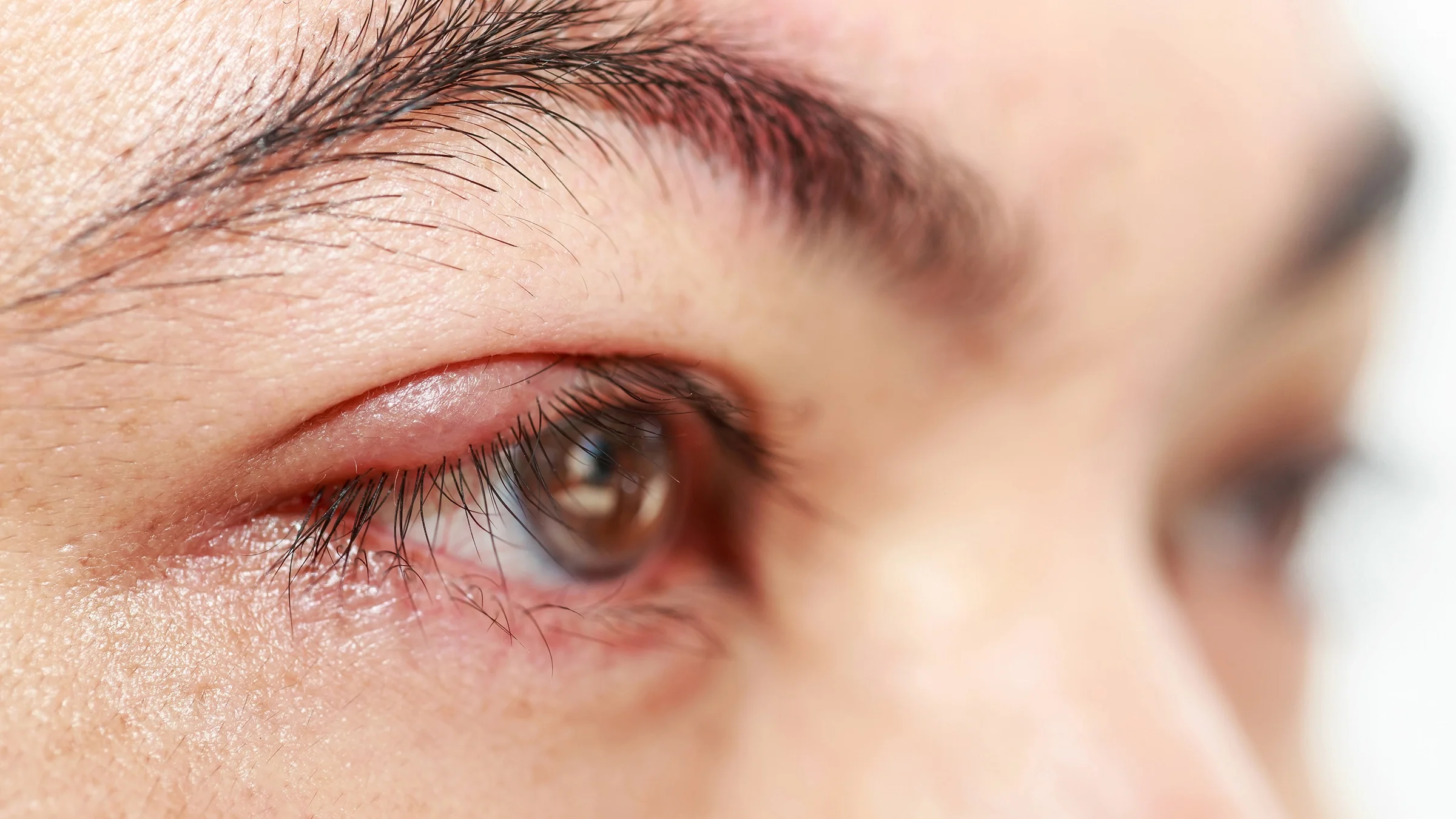Key takeaways:
A stye is a red, tender bump that forms on the eyelid. Styes will heal on their own, but it can take several weeks for them to go away.
You can care for your stye at home with warm compresses and eyelid scrubs. Your healthcare provider can also prescribe antibiotic eye ointment to help treat your stye.
Never pop a stye — this can lead to serious eye infections.
Have you ever developed a red, painful bump on your eyelid? If so, you likely experienced an eyelid stye. Styes can be uncomfortable and can affect your appearance. Most people want to get rid of a stye as fast as possible. But it’s important to know how to treat a stye safely (and know what to avoid).
What is a stye?
A stye is also called a “hordeolum.” It’s a bump on the eyelid that develops when there’s an infection in an eyelid gland.
Eyelid glands make oils that keep eyes moist and healthy. But these glands can get blocked or clogged and then infected, which creates a stye.
You have glands on the inside and outside of your eyelid. So it’s possible to develop two kinds of eyelid styes:
External hordeolum: These are styes that develop on the outside of your eyelid.
Internal hordeolum: These are styles that develop on the inside of your eyelid.
Styes are extremely common — so common that researchers don’t bother measuring how often people get them. In general, most people will develop one or two styes in their life. Some people are more prone to styes and get them more often. But whether you’re experiencing your first stye or your 13th, it’s important to understand where they come from and how to treat them.
Stye symptoms
A stye is pretty easy to spot. When you develop a stye, you’ll notice a red bump at the edge of your eyelid or on the inside of your eyelid. The bump is usually painful, and it may have a whitehead. The bump usually starts out small, but it may get slightly bigger. But it shouldn’t take up your entire eyelid.
Some people also experience symptoms like:
Eyelid redness
Eyelid swelling
Eye drainage
A burning or irritating sensation in the eye
A feeling like something is stuck in the eye
Blurry vision
Read more like this
Explore these related articles, suggested for readers like you.
Most people only have one stye at a time. But since there are many glands on your eyelid, it’s possible to have multiple styes at the same time.
Are styes and chalazions the same?
People often mix up chalazions and styes because both look like eyelid bumps. But it’s easy to tell them apart based on the location of the bump and your symptoms:
Location: Chalazions always form on the inside of the eyelid. But styes can form on either the outside or the inside of the eyelid. Chalazions tend to form on the upper eyelid, while styes are just as likely to form on an upper or lower eyelid.
Onset: Chalazions tend to form gradually over a few days. You may notice a small bump that slowly gets bigger. But styes develop all of a sudden. Most people go from having no symptoms to having a fully developed stye in less than a day.
Pain: Chalazions aren’t painful. They develop when an oil gland inside the eyelid gets blocked. This leads to swelling, although the blockage doesn’t get inflamed or infected. But styes are always inflamed and painful.
What causes a stye?
Skin bacteria, especially Staphylococcus aureus, cause most styes. Bacteria normally live on the skin and are important for your skin’s health. But sometimes these bacteria can get into breaks in the skin and cause skin infections.
Bacteria can also cause infections when they get trapped somewhere they shouldn’t be — like a blocked eyelid gland.
Some simple activities bring bacteria in contact with your eyelid. And this increases your risk of developing a stye. Most people don’t think twice about these activities because they’re so natural. Here are some things that can increase your risk of developing styes:
Touching or rubbing your eyes without washing your hands first
Putting in or taking out contact lenses without washing your hands
Putting on mascara or eye makeup, especially if the makeup is over a month old
Using makeup brushes on or your near your eyelids, especially if they’re not washed regularly
You’re also more likely to develop a stye if you have a medical condition that affects your eyelid gland’s natural oil production and skin barrier. Medical conditions that increase the risk of developing styes include:
Blepharitis
Are styes contagious?
No. Technically, styes are not contagious. You can’t pass your stye directly to another person.
But you can pass the bacteria that’s causing your stye to another person. For example, if you share eye makeup, brushes, or something else that comes in contact with your stye, someone can pick up bacteria from those objects. But picking up the bacteria doesn’t mean they’ll develop a stye, too. That’s because it takes more than just having the bacteria on your skin to get a stye.
Stye treatment and self-care
Most styes go away on their own. Your body fights off the infection, and then your eyelid heals.
But there are several things you can do to make sure healing goes smoothly.
Apply warm compresses
Warm compresses help open your clogged eyelid gland. This lets the debris, or gunk, stuck inside your stye flow out so your stye can start to heal. Apply a warm compress directly to your stye for 15 minutes about 3 to 4 times per day.
To make a warm compress, use warm water and a washcloth. Or you can make one with a tea bag. Just be sure to use a new tea bag or clean cloth each time, otherwise the bacteria can get back into your eyelid gland.
These types of compresses tend to cool off quickly. So if your compress does not last the full 15 minutes, you can try making a compress with rice and a clean sock:
Fill a clean sock with dry, white rice.
Microwave it for 15 seconds.
Check to make sure the sock isn’t too hot.
Lay it directly over your eyelid
You can also try reusable warm packs made especially for eyes, like Bruder Mask, MediViz Eye Mask, and Medcosa Heat Eye Bag.
Do eyelid scrubs
Doing eyelid scrubs once a day will help soothe your eyelid glands. It will also remove any buildup of dead skin cells or other things that can clog glands. You can make your own eyelid scrub at home with no-tear shampoo or a gentle face wash.
To use an eyelid scrub, shut your eyes and then, with one finger, gently rub the product on your eyelid back and forth at the base of your eyelashes about a dozen times. Do this on your upper and lower eyelashes.
You can also buy eyelid scrubs over the counter. OcuSoft is a popular brand that comes with textured pads for easy application. After, to help fight off bacteria, you can also use antiseptic eyelid sprays, like Avenova or Hypochlor.
Keep out new bacteria
After working so hard to fight off the bacteria that’s causing your stye, the last thing you want is more bacteria to get into your eyelid glands.
Avoid activities that can increase how much bacteria gets near your eyes. Try not to touch or rub your eyes, and wash your hands often.
If you wear contact lenses, take a break and switch to glasses until your stye heals. It’s also a good idea to avoid all eye makeup until your stye goes away. And make sure to switch mascara wands and wash all makeup brushes once you’re ready to go back to your usual routine.
How long does a stye last?
Most styes last between 1 to 2 weeks. They usually get bigger over the first few days. Then, over the next week or so, they gradually get smaller and disappear.
Although it might be tempting, never pop a stye. This can cause the bacteria to get pushed into other parts of your eye. And that can lead to serious infections.
If your stye doesn’t go away after a week, or it gets worse despite these treatments, see your healthcare provider. You might need antibiotics to treat your stye.
How to prevent styes
Here are some tips to help you avoid another stye:
Always wash your hands before putting in or taking out contact lenses.
Avoid touching your eyes if you haven’t washed your hands.
Wash your face and remove makeup before going to sleep.
Replace any makeup you use near your eyes every 6 months.
Wash your makeup brushes regularly.
Wash your eyelids regularly if you’re at higher risk of getting a stye.
The bottom line
A stye is a painful red bump on the eyelid. Styes develop when oil glands in the eyelid get infected. People who wear contact lenses or have a history of dry eye and blepharitis are more likely to develop styes.
You can treat most styes at home with warm compresses and eyelid scrubs. But if your stye lasts longer than a week and isn't getting better, you may need to start antibiotics. Never pop or squeeze a stye — this lets the bacteria enter other parts of your eye and can cause a serious eye infection.

Why trust our experts?


References
American Academy of Ophthalmology. (2022). Can I wear my contact lenses if I have a stye? EyeSmart.
American Academy of Ophthalmology. (2022). Can warm tea bag compresses help reduce infections of the eye? EyeSmart.
American Academy of Ophthalmology. (2022). Is it OK to pop a stye? EyeSmart.
American Academy of Ophthalmology. (2023). Are styes in the eye contagious? EyeSmart.
Baharestani, S., et al. (2022). Stye. American Academy of Ophthalmology.
Boyd, K. (2023). What is the difference between a stye and a chalazion? Causes, symptoms, treatment. American Academy of Ophthalmology.
Bragg, K. J., et al. (2023). Hordeolum. StatPearls.
Jordan, G. A., et al. (2023). Chalazion. StatPearls.
McStay, C. (2023). Stye and chalazion. British Medical Journal Best Practice.
National Health Service. (2021). Stye.
Willmann, D., et al. (2021). Stye. StatPearls.


















